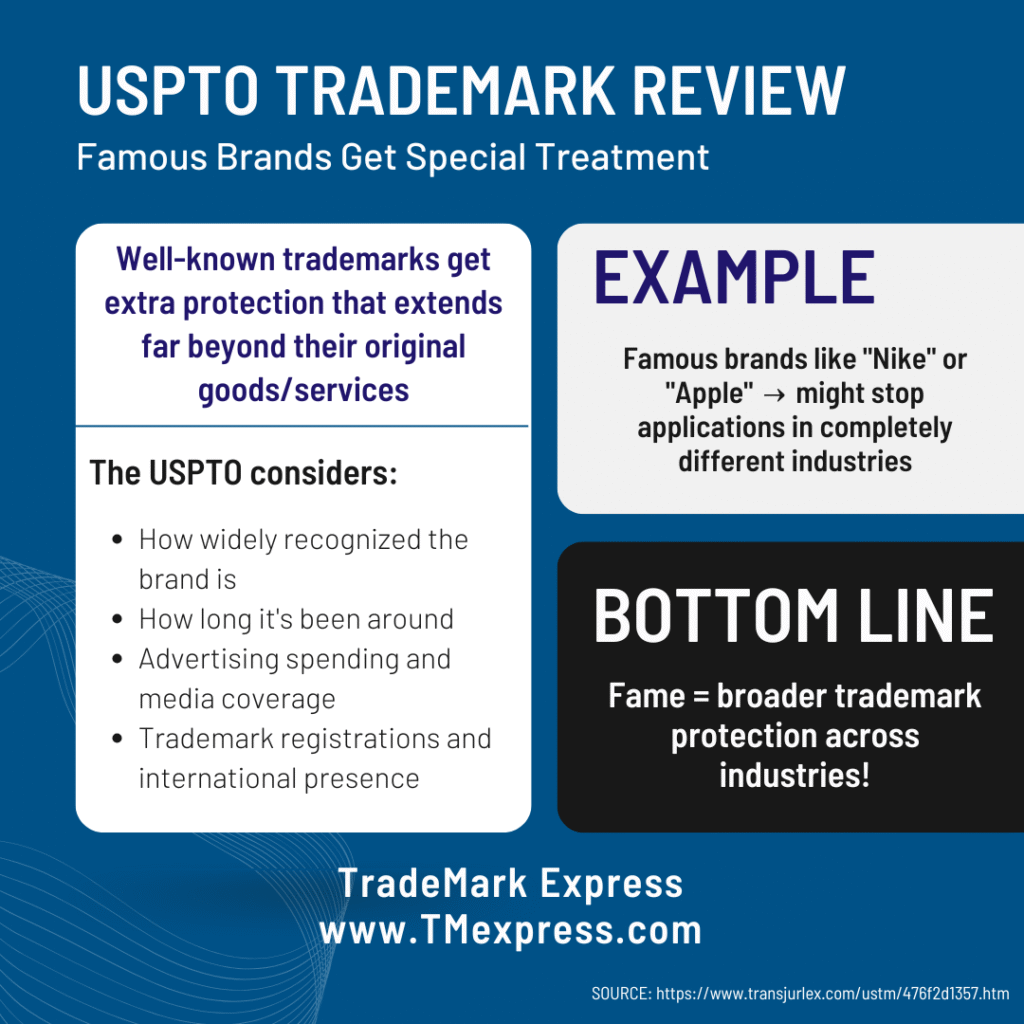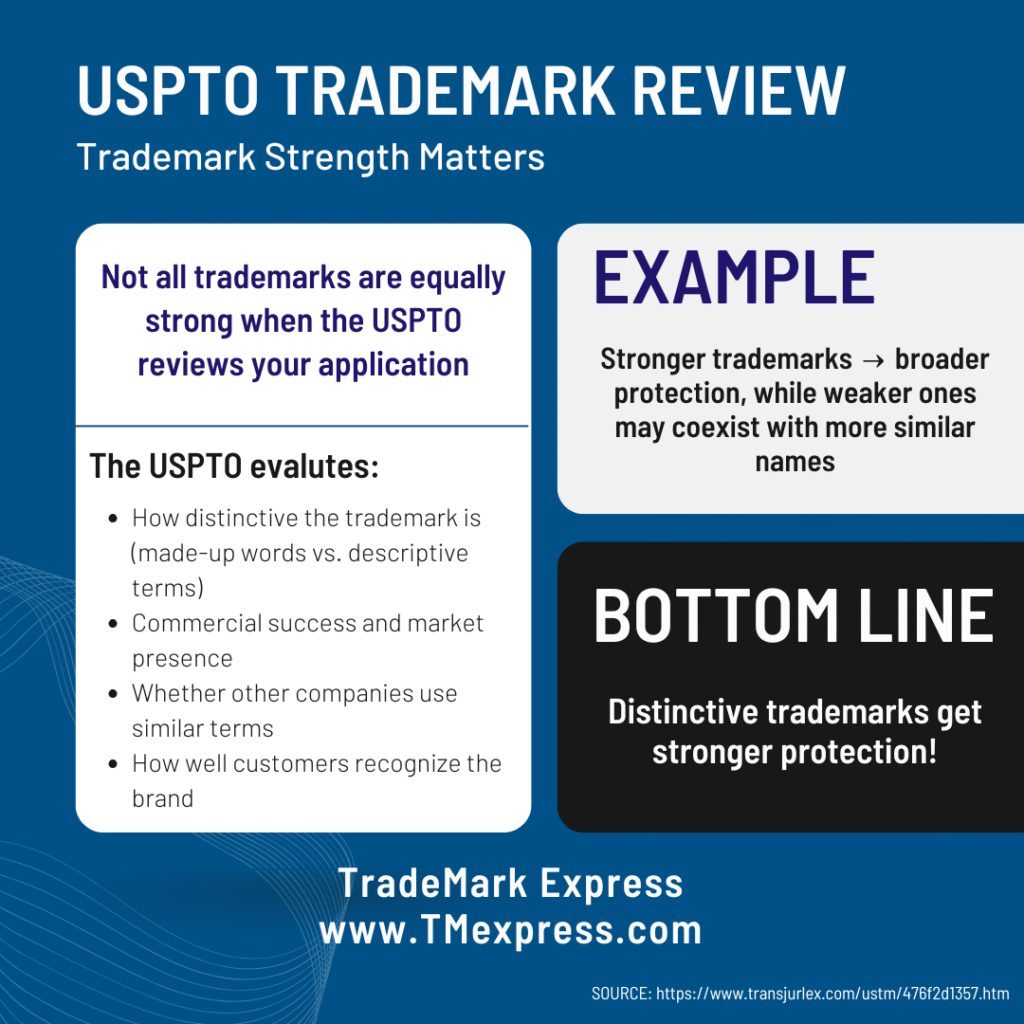How the USPTO Reviews Your Trademark Application
When you submit a trademark application, a USPTO examining attorney will review it to answer one main question: Might your trademark confuse customers in the marketplace?
Understanding how this review works can help you make better branding choices and avoid trademark application problems.
The Big Question: Will Customers Get Confused?
The USPTO’s main job is protecting customers from being misled about where products or services come from. But figuring out if a likelihood of confusion refusal might happen isn’t simple—USPTO examining attorneys look at several different factors. Let’s explore a handful –
What the USPTO Examines
1. Your Products or Services vs. Existing Ones
The examining attorney doesn’t just compare identical products/services. They might also consider:

- Direct competitors (the obvious matches)
- Related goods/services that customers might expect from the same company
- Items sold in the same stores
- Services that often go together
For example, if you want to trademark a name for coffee, it might conflict with existing trademarks for tea, energy drinks, or even coffee shop services—depending on how customers think about these markets.
2. Where Products Are Sold
How and where products reach customers matters. The USPTO might look at:

- Types of stores (specialty shops vs. big box retailers)
- Online sales and websites
- Business-to-business vs. consumer sales
- Geographic areas where products are sold
A trademark for industrial equipment sold only to manufacturers might face different issues than a consumer product sold in grocery stores, even if the names are similar.
3. Who Buys These Products
The examining attorney considers whether the same customers would see both trademarks:

- Who typically buys these products
- How much expertise buyers have (industry professionals vs. everyday shoppers)
- Price levels and market types
- How often people buy these items
Business experts buying specialized equipment are less likely to get confused than everyday shoppers making routine purchases.
4. Famous Brand Names
Well-known trademarks get extra protection that can extend far beyond their original products. When reviewing applications that might conflict with famous brands, examiners might consider:

- How widely recognized the brand is
- How long it’s been around
- Advertising spending and media coverage
- Trademark registrations and international presence
Famous brands like “Nike” or “Apple” might be able to stop applications in completely different industries because so many people know these names.
5. How Strong the Existing Trademark Is
Not all trademarks are equally strong. The USPTO might evaluate:

- How distinctive the trademark is (made-up words vs. descriptive terms)
- Commercial success and market presence
- Whether other companies use similar terms
- How well customers recognize the brand
Stronger trademarks might get broader protection, while weaker ones may have to coexist with more similar names.
What This Means for Your Business Strategy
From a researcher’s perspective, understanding how the USPTO evaluates these factors helps you make smarter trademark decisions. But the most important step you can take is conducting comprehensive trademark research—ideally before you start using a name commercially, and definitely before filing a trademark application.

Comprehensive trademark research goes far beyond a simple Google search or basic USPTO database check. It involves systematically examining federal trademark and state trademark databases, common law uses, domain names, business registrations, and industry-specific sources to identify potential conflicts across all the factors the USPTO considers.
This research analyzes not just identical matches, but related goods and services, similar distribution channels, overlapping customer bases, and existing trademarks that might be strong enough to block your application.
The timing of this research matters enormously. Conducting thorough research before you launch a brand can save you from costly rebranding efforts down the road. If you discover potential conflicts early, you have options: choose a different name, modify your approach, or develop strategies to coexist with existing marks.
Once you’ve invested in marketing, signage, inventory, and customer recognition, changing course becomes exponentially more expensive and disruptive to your business.
The Bottom Line
From a researcher’s standpoint, the USPTO’s trademark review process balances protecting existing brands with allowing legitimate new trademarks into the marketplace. By understanding what examining attorneys consider when evaluating potential confusion, you can make more informed branding decisions.
But remember—comprehensive trademark research conducted before you commit to a name is your best protection against costly surprises later in the process.
TradeMark Express provides comprehensive trademark research services to help businesses understand potential USPTO concerns. Our detailed reports analyze the factors that examining attorneys consider, giving you insights to make informed branding decisions. Contact us to learn how professional trademark research might strengthen your application strategy.
